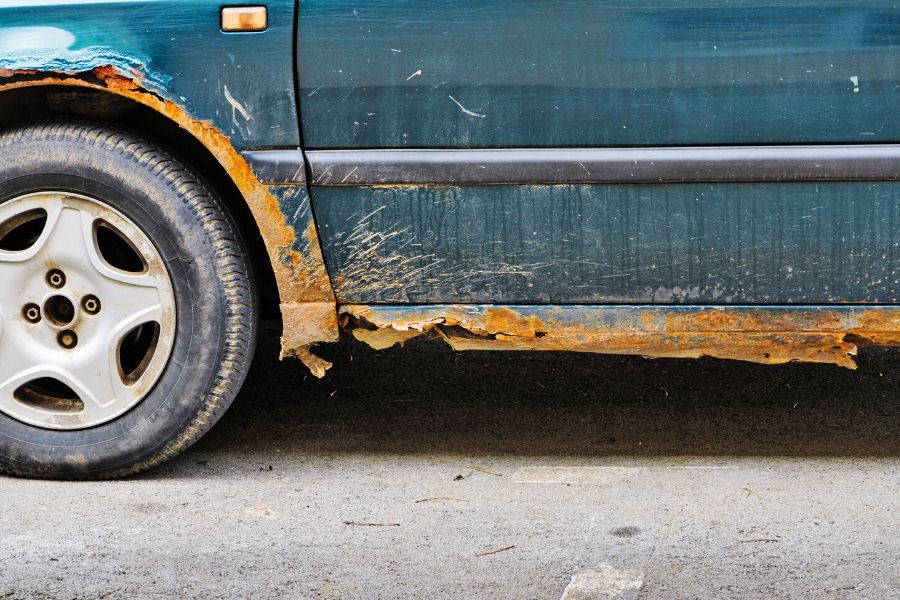If you’ve ever taken a trip down south to a tropical country, you may be surprised to see how many old cars are still on the roads down there! One big reason why these decades-old cars are still running in those places is because of the hot weather. Without a damaging winter season, cars are able to avoid getting rusty and worn down, unlike here in Vancouver where winter wreaks havoc on the metal bodies of our cars. While it is tempting to blame the cold, wet winter weather entirely for our cars’ shorter lifespans, there is one major culprit that causes a lot of the rust and paint damage. That culprit is salt, and although it keeps the roads safer to drive on in winter, it definitely causes damage to a vehicle’s paint finish over time.
What Salt Cause Paint Damage?
Road Salt
Road salt is extremely effective when it comes to reducing the accumulation of dangerous ice on the roads in winter. The increased traction provided by road salt mixtures makes it far safer to drive in winter conditions. Without road salt, getting around in winter would be extremely dangerous, so we can be grateful at least about that aspect. Due to the corrosive nature of salt however, regular exposure in winter means it is more likely to cause damage to the paint finish on your vehicle.
When we drive around in winter, the tires on our cars kick up lots of slush and salt from the road. We can often see this buildup in the wheel well of our cars. Over time, the water will melt away, leaving a corrosive salt residue behind on the paint finish and underside of the car. If this residue is allowed to remain for an extended period of time, the salt will eat away at the paint finish. It will also cause oxidization on any metal surface, which can quickly lead problems with rust spots. If these spots aren’t properly treated, the rust will spread.
Avoiding Issues with Salt
To keep your car from deteriorating due to rust and a compromised paint finish, it is important to take some steps to protect your vehicle from the salt in winter.
- Adding a protective wax coat to your paint finish before winter will keep the majority of salt from negatively affecting your paint. You may also consider getting a permanent protective layer installed on the underside of the car as well.
- In addition to these protective layers, you should try to get your car washed at least once a month. This is especially important if you start to see that salty residue forming on the car. By keeping the body clean, rust won’t have a chance to build up at all, even with regular exposure to salt on the road.
How Long Does It Take for a Car to Rust from Salt
The time it takes for a car to rust from salt exposure varies depending on several factors, including climate, salt concentration, and car maintenance. In areas with heavy winter salt use, visible rust can start to form in as little as one to two years if the car’s paint is compromised, such as by chips or scratches. Regularly washing your car, including the undercarriage, and applying a protective wax coating can significantly extend the time it takes for rust to develop.
How to Protect Car Paint in Winter
- Wash Your Car Frequently: Regularly wash your car to remove salt and road grime. Focus on the undercarriage, wheel wells, and all painted surfaces. Use a car wash designed for cold weather to prevent freezing.
- Apply a Protective Wax: Apply a high-quality automotive wax before winter. This creates a protective barrier against salt and moisture, reducing the risk of paint damage and rust.
- Use a Ceramic Coating: Consider applying a ceramic coating for long-lasting protection. Ceramic coatings provide a durable shield against salt, UV rays, and other environmental factors.
- Park Indoors or in a Garage: Whenever possible, park your car indoors or in a garage to shield it from salt exposure and extreme cold.
- Install Mud Flaps: Mud flaps can help minimize the amount of salt and debris that gets thrown onto your car’s lower body panels.
- Regular Inspections: Periodically inspect your car for chips, scratches, or paint damage. Promptly repair any imperfections to prevent salt from penetrating the paint. By taking these steps, you can effectively protect your car’s paint from the corrosive effects of winter salt and maintain its appearance for years to come.
For more info about protecting your car’s paint finish, or to get quality auto body repairs in Vancouver, be sure to contact us at Super Euro Auto Body today.

